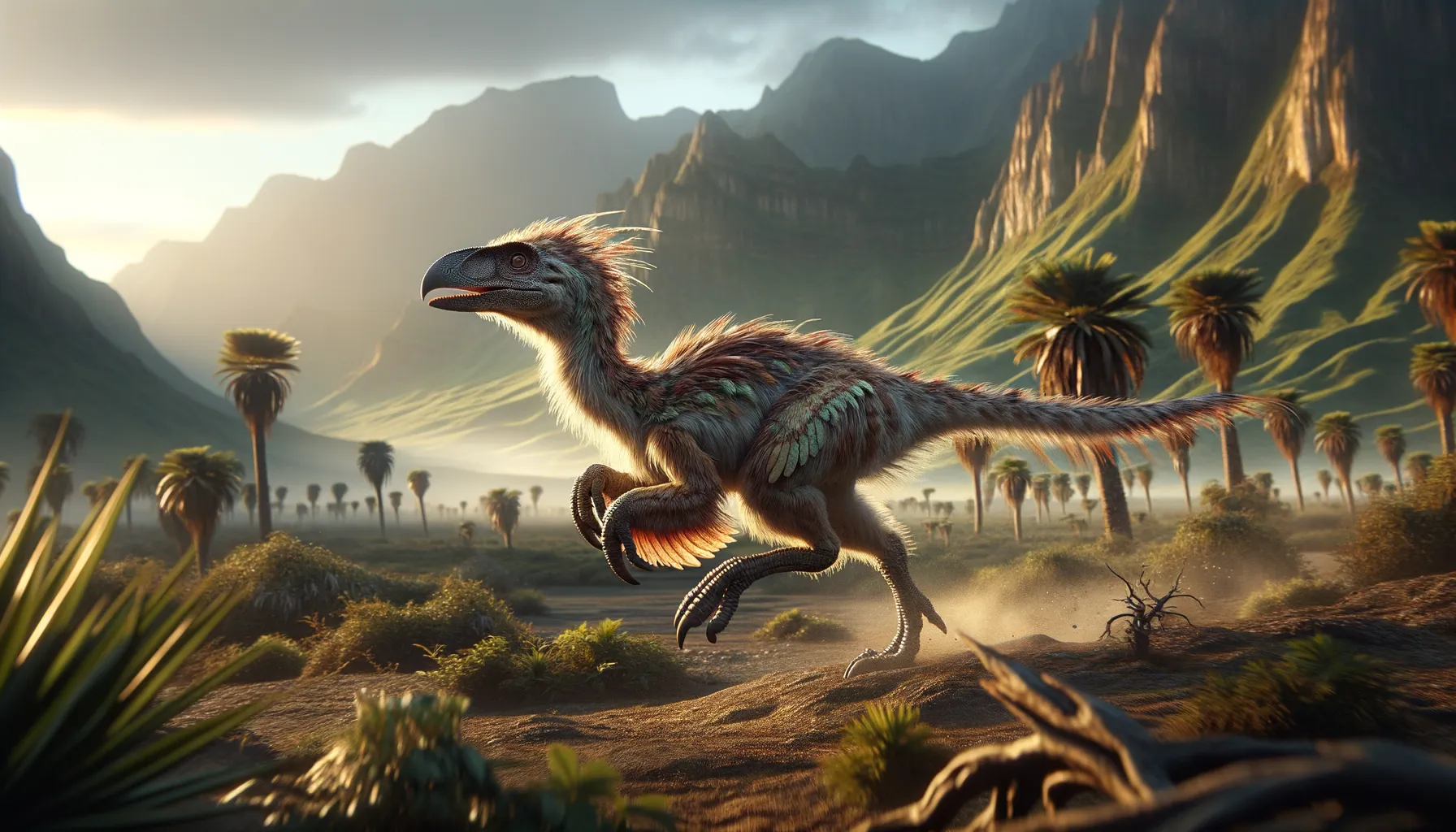
Khaan
Swift and cunning, mastering the ancient terrain.
Period
Cretaceous
Length
Measured around 1.8 meters long.
Height
Stood around 1 meter tall.
Weight
Roughly 25 to 35 kilograms.
Khaan was a small, agile dinosaur known for its bird-like features and sharp-toothed beak. It roamed the ancient landscapes of what is now Central Asia during the Late Cretaceous period, approximately 75 million years ago. Its skeletal structure suggests a capacity for rapid movement, possibly aiding in evading predators. This dinosaur provides valuable insights into the evolutionary link between non-avian dinosaurs and birds. Its discovery has enriched our understanding of theropod diversity and adaptation.
Diet
Khaan likely had an omnivorous diet, feeding on a combination of plants, insects, and small animals. Its sharp beak and claws would have been well-suited for catching prey and accessing a variety of food sources.
Hunting
Khaan may have relied on its agility and speed to capture small prey. It could have used its keen eyesight and quick reflexes to detect and chase down potential food. Cooperative or social hunting behaviors could be a possibility but are not well-documented.
Environmental challenges
Khaan lived in a dynamic, shifting environment that presented several challenges, such as varying food availability and climatic changes. Predatory threats would have been constant, requiring vigilance and quick reflexes for survival. Seasonal variations could have influenced its resource-gathering strategies and movement patterns. Water availability might have also been a critical factor impacting its survival during different periods.
Speed
Khaan was likely swift, with agile movements.
Lifespan
Estimated lifespan around 10 to 15 years.
First discovery
First discovered in Mongolia in the early 2000s.
Fun Facts
- Khaan is named after the Mongolian word for 'ruler' or 'lord', reflecting its regal appearance.
- This dinosaur belonged to the group called oviraptorosaurs, known for their bird-like features.
- Khaan lived approximately 70 to 66 million years ago during the late Cretaceous period.
- Fossils of Khaan have been predominantly found in Mongolia, giving insight into the region's prehistoric life.
- Khaan had a beak-like mouth and was likely omnivorous, consuming both plants and small animals.
- Despite its fierce name, Khaan was relatively small, about the size of a turkey.
- Khaan's skeleton structure suggests it could have been a fast and agile runner, useful for escaping predators.
Growth and Development
Khaan's young likely grew rapidly, benefiting from rich nutritional resources available in its environment. Bone analysis suggests that these dinosaurs experienced quick developmental stages, reaching maturity relatively fast. Their skeletal structures indicate that physical development was optimized for speed and agility. The transition from juvenile to adult might have involved changes in diet preferences and social roles within their groups.
Habitat
Khaan inhabited the arid, desert-like regions of Central Asia, characterized by a mixture of open landscapes and scattered vegetation. This environment provided opportunities for foraging a diverse diet and evading larger predators. It likely lived in areas with seasonal water sources, which influenced its migratory patterns. Changes in the environment would have required adaptability to shifts in terrain and climate.
Interaction with other species
Khaan might have had interactions with both predators and other herbivorous dinosaurs, competing for resources. It likely coexisted with other theropods, sharing the ecosystem without direct conflict. Its role in the food web would have influenced its need for vigilance against larger carnivores. Cooperative behavior or competition with similar species might have shaped its social dynamics.
Natural lifespan
Its natural lifespan was around 10 to 15 years.
Reproduction
Khaan likely reproduced by laying eggs in nests, possibly displaying protective nurturing behaviors. Fossil evidence suggests clutch sizes similar to modern birds, hinting at a reproductive strategy that favored having multiple offspring. Parental care might have been crucial for early developmental stages, ensuring high survival rates. Its eggs and nests would have been vulnerable to environmental threats, necessitating a keen sense of protection from parents.
Social behaviour
Khaan might have exhibited social behaviors, potentially living in small groups. Such group dynamics could aid in protection against predators and enhance foraging efficiency. Interactions among group members may have involved vocal and visual communication cues. The complexity of its social structure remains largely speculative, necessitating further evidence for detailed understanding.
Fossil locations
Fossils of Khaan have been primarily found in the Djadokhta Formation of Mongolia. These discoveries have provided crucial insights into its anatomy and lifestyle. The well-preserved remains offer a window into the ecosystem that Khaan inhabited millions of years ago. Continued excavations in this region may yield further finds, deepening our understanding of this unique dinosaur.
